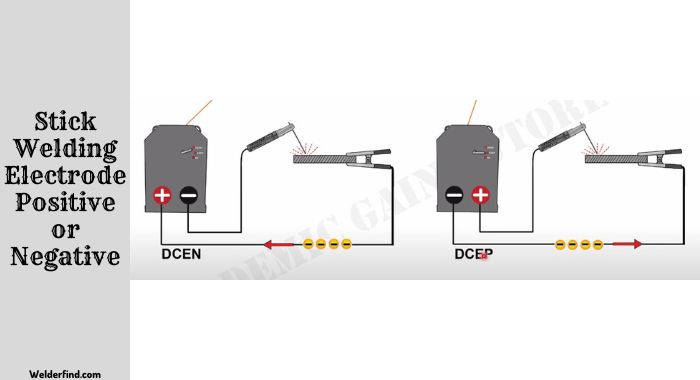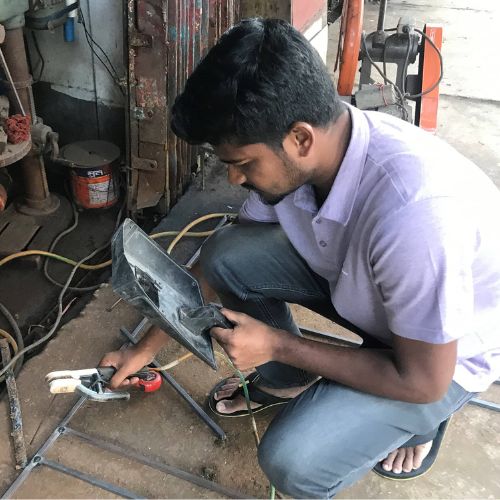Stick welding is easy to use, affordable, and produces strong welds. It can form effective joints, even on dirty or rusty items.
But is stick welding electrode positive or negative? Choosing the right electrode is vital to weld two metal pieces perfectly and to control the metal’s temperature.
What Electrode Used In Stick Welding?
Stick welding rods are metal-type materials. It sustains and stabilizes the arc. Plus, these electrodes supply filler metals to join the weld perfectly.
This metal filler material has chemical coatings to protect it from getting damaged and minimizes the risk of weld bead cracking.
Is Stick Welding Electrode positive or negative?
Stick welding rods can be negative or positive depending on the welding polarity type and welding process.
Direct current (DC) or direct current electrode positive (DCEP) are connected to the positive terminal, whereas direct current electrode negative (DCEN) are connected to the negative terminal.
Welders often use AC current to produce severe effects in the welding process. In such a case, flux shielded arc welding rods will be positive in the half cycle and negative in the other half cycle.
Differences Between Positive Or Negative Electrode
Positive electrodes in shielded metal arc welding provide a reverse polarity, where electrons travel from the electrode to the workpiece.
But negative electrodes in an electric arc welding provide a straight polarity, where electrons travel from the electrode tip to the base plates. Positive electrodes in stick welding provide deeper penetration in the base metal being welded.
In contrast, negative electrodes in stick welding melt off the electrode rapidly for a faster deposition rate.
How To Determine The Polarity Of Electric Arc Welding Electrodes?
Go Through the Electrode Packaging
Like other product packaging, electrodes have detailed information on their packaging. Check the wrapper to figure out whether you need to use DCEP or DCEN polarity.
Select The Correct Polarity
Your polarity should match the kind of electrode you use. If your stick welding rods have a special coating, use DCEP polarity. Otherwise, use DCEP polarity if the electrodes don’t have any coating.
Know Your Welding Requirements
How do you choose polarity? The transformation of electrons from the rod to the metal object will be affected based on the polarity type.
If your shielded metal arc welding needs deeper penetration and good fusion, DCEP polarity is a better choice. But DCEN polarity is a good option when you need higher wire feed speeds and voltages.
Say No To Incorrect Polarity
Avoid using an incorrect polarity to prevent poor weld quality and weaker welds. It will result in too much spatter, nasty penetration, and insufficient control in the welding arc.
Pay Attention To Expenses
Not all polarity will consume the same amount of electrode. Some eat up more than others. It affects the overall welding expense. Hence, cautiously choose a particular option.
Advantage Of Positive Polarity
- Reversed polarity produces higher heat to work on thicker materials that need deeper penetration.
- It creates a focused arc that tends to be more stable and easier to control.
- Welders have enhanced control over bead shape to create narrower, more precise weld beads.
Disadvantage Of Positive Polarity
- Reversed polarity may cause higher spatter, resulting in a less precise and attractive weld bead.
- It is a short-time electrode life, which can increase downtime and reduce productivity as you must frequently replace the electrode.
Advantage Of Negative Polarity
- Straight polarity can melt off the electrode quickly to achieve a rapid deposition rate.
- It provides a cooler welding arc with less heat input to avoid warping or distortion in thinner materials.
- Achieving a cleaner, smoother appearance will be easygoing due to minimal spatter.
Disadvantage Of Negative Polarity
- Straight polarity produces lower heat to work, making it inappropriate for thicker materials that need deeper penetration.
- It creates a distracted arc that tends to be unstable and difficult to control.
- Welders also have less control over bead shape. They are prone to create poorly shaped weld beads.
Uses Of Positive Polarity In Electric Arc Welding
Thicker Materials
Reversed polarity is used for thicker and stronger materials requiring deeper penetration and a stronger, more reliable weld joint.
Welding Steel
Welders often use reversed polarity in stick welding to weld steel as it can help to increase the melting rate and produce a more concentrated arc.
Harder Or Tougher Materials
NOREM, carbides, high-chromium white irons, nickel-based alloys, etc., are pretty tough materials. They are hard and wear-resistant. You can use reversed polarity to weld them.
Uses of Negative Polarity in Electric Arc Welding
Thin Materials
You can use straight polarity to weld thin metals such as basic carbon steel, sheet metal stainless steel, aluminum, etc.
Pipes And Tubing
Straight polarity is commonly used in electric arc welding to weld pipes and tubing, such as HVAC systems, water and gas pipelines, and various other industrial applications
Other Applications
Welders also use negative polarity to weld various items, such as airplanes, boats, automotive parts, kitchen appliances, medical equipment, etc.
What Points To Consider When Selecting A Polarity?
You may feel confused about whether to choose a positive or negative polarity. Before choosing a particular polarity, the followings are the crucial factors you should not overlook.
How Thick is the metal?
Straight polarity is better for metals less than 1/8 inch (3.175 mm). But when the metal is 1/4 inch to several inches thick, positive polarity is a better choice.
What Kind Of Material You Weld?
Not all metals you weld need the same polarity. For example, carbon steel, sheet metal, and stainless steel need straight polarity.
In contrast, reversed polarity is a better choice for high-chromium white irons, nickel-based alloys, etc.
What Result Do You Prefer?
Do you prefer less spatter and minimal clean-up hassles? If so, negative polarity appears better. But when you want to weld faster, reversed polarity is more appropriate.
Where Will You Weld?
What is the surrounding environment where you will weld?
Is it an open or a restricted space? You won’t use the same polarity for an enclosed and widely open space.
Wrapping Up
Your welding skill and technique will definitely be necessary for successful welding. But you can’t overlook the importance of the correct polarity for better outcomes in electric arc welding.
Hopefully, you got a clear idea of whether the stick welding electrode is positive or negative.

